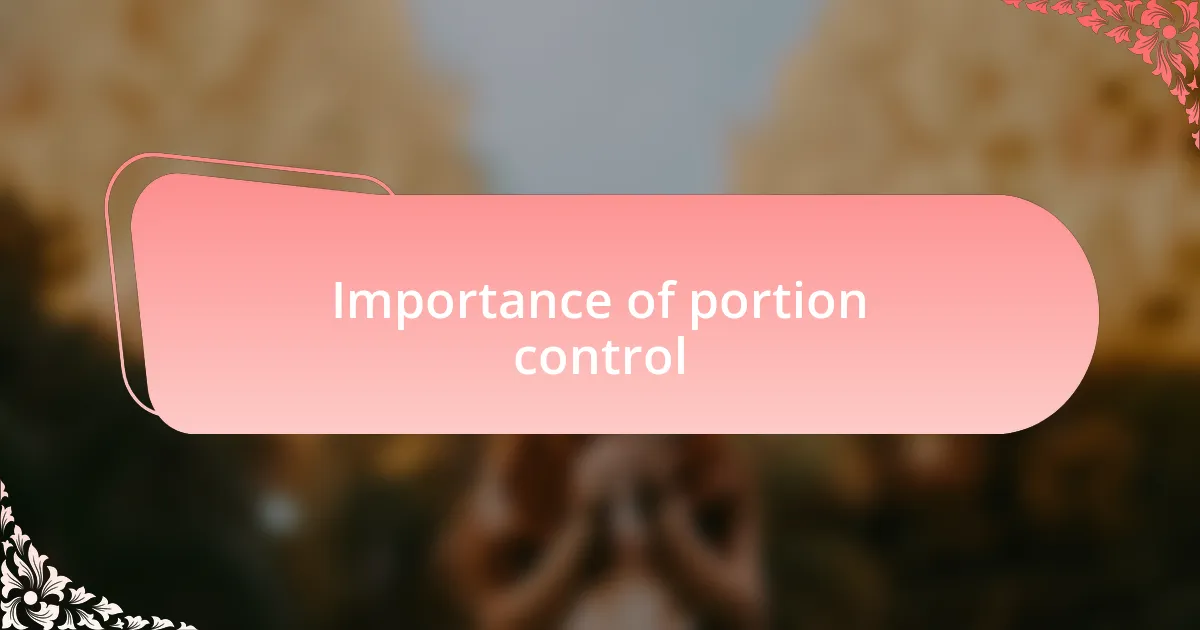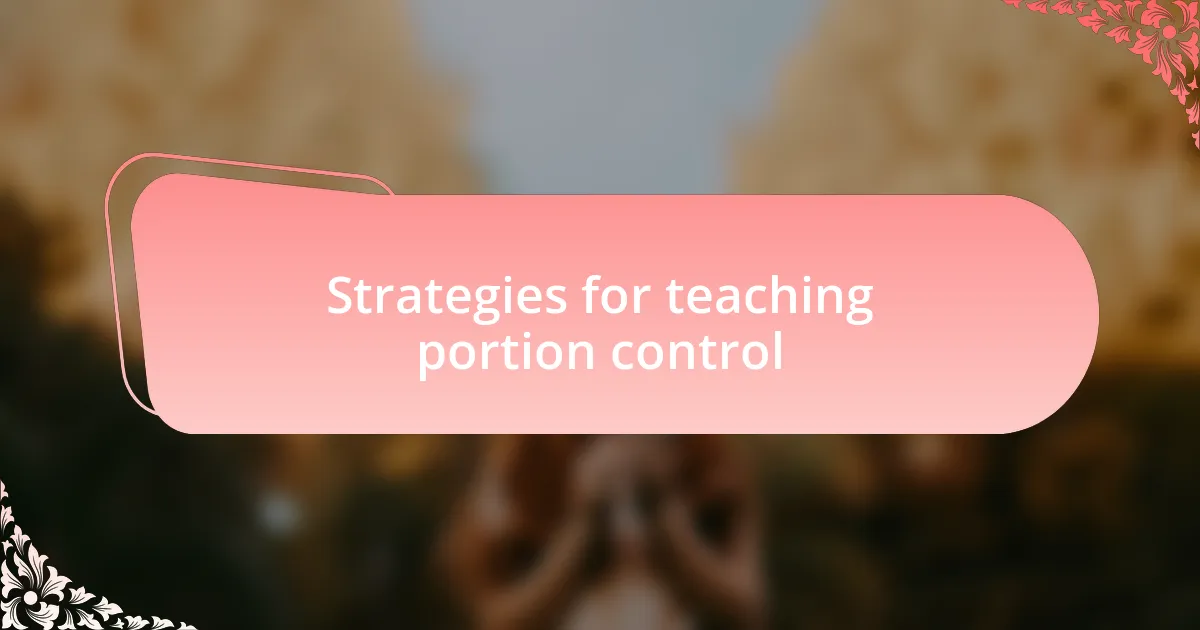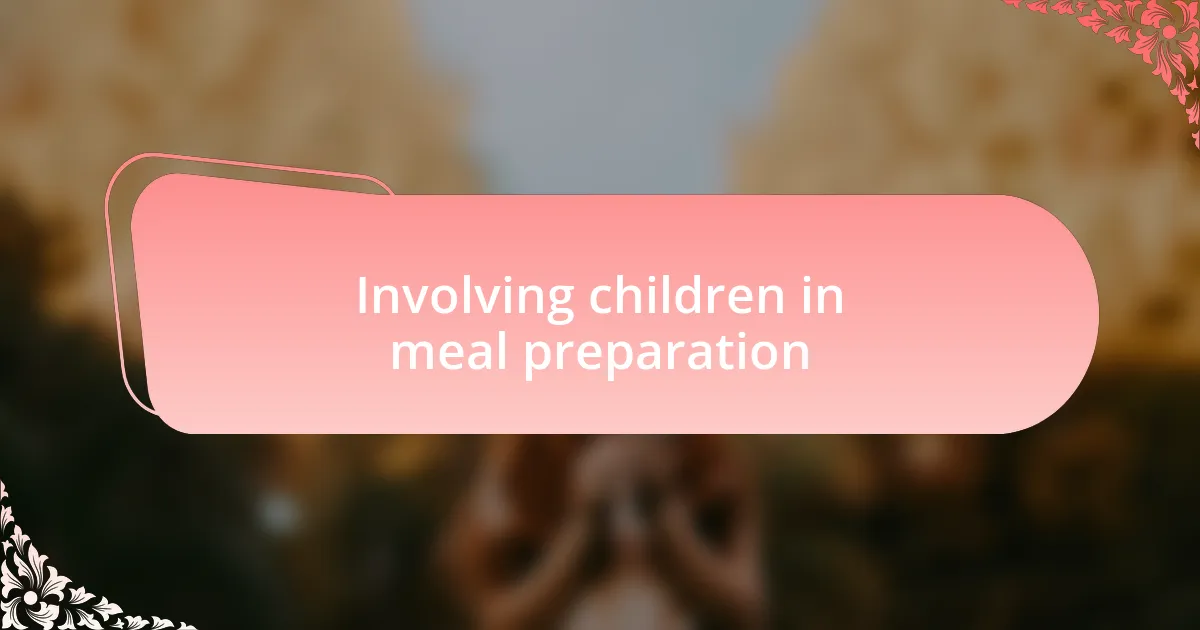Key takeaways:
- Portion control fosters healthy eating habits and reduces food waste by encouraging mindful eating practices.
- Utilizing visual cues and involving children in meal preparation helps them understand portion sizes and nutritional value.
- Celebrating progress in portion control, such as serving smaller amounts, reinforces positive habits and self-regulation in children.

Understanding portion control
Portion control is about understanding the right amount of food to serve on each plate, which can be quite a challenge, especially with children. I remember when I first noticed my kids often left food on their plates; it made me wonder, are we serving too much? Reflecting on this, I realized that portion sizes matter not only for managing waste but also for teaching them mindful eating habits.
I discovered that using smaller plates can create a visual trick; it makes servings look larger than they are. One evening, I decided to test this out. I served dinner on salad plates instead of dinner plates, and to my surprise, my children enjoyed the meal just as much, feeling satisfied without the pressure of a heaping portion. It sparked a conversation about listening to their bodies and recognizing when they are full.
Understanding portion control also involves recognizing hunger cues. I used to think that finishing every bite was the goal, but I learned that it’s crucial to encourage my kids to eat until they’re satisfied, not stuffed. How many times have we seen a clean plate as a sign of success? This shift in mindset has made our family meals more enjoyable and less stressful, promoting healthier habits that I hope will stick with my children for life.

Importance of portion control
Portion control is essential for fostering healthy eating habits in children. I recall a moment when my daughter was playing with her food instead of eating. It struck me then that if I served smaller portions, she might feel less overwhelmed and more inclined to explore her meal. It’s fascinating how simply adjusting the amount on her plate changed the dynamic at the dinner table.
By teaching kids about portion sizes, we equip them with the skills to make better choices later in life. I remember explaining to my son that just like toys can have too many pieces, so can our meals. This simple analogy resonated with him, and he began to appreciate that moderation could lead to more enjoyable experiences rather than feeling pressured to eat everything on his plate.
Moreover, portion control can significantly reduce food waste, a reality that I became increasingly aware of during our family meals. One night, I decided to save leftovers from a meal instead of tossing them because the portions were too large. I found it gratifying to utilize those leftovers creatively the next day. Have you ever thought about how controlling portions not only nurtures our bodies but also teaches valuable life lessons about sustainability?

Strategies for teaching portion control
One effective strategy I found was using visual cues to help my kids grasp portion sizes. For instance, I introduced the concept of a “balanced plate” by dividing it into sections for vegetables, proteins, and grains. It was amazing to watch my children start to serve themselves by using visual references rather than guessing, and it often sparked conversations about why particular food groups are important.
Another approach that really resonated in our home involved a simple game during mealtimes. I would challenge my kids to guess how much food they needed for their hunger level, creating a fun and interactive atmosphere. This not only made them more aware of their bodily signals but also encouraged them to take ownership of their choices. Have you ever noticed how a playful approach can transform a mundane task into a valuable lesson?
Finally, I discovered that involving my children in meal preparation fostered a better understanding of portion sizes. When they helped measure ingredients, they’d inevitably ask questions about serving sizes and nutrition. The enthusiasm in their eyes was palpable as they learned through experience. I often found myself wondering how much more effective this engaging technique was compared to me simply telling them what to do. Engaging children in the kitchen not only teaches them to love cooking but also sets a foundation for lifelong healthy habits.

Involving children in meal preparation
Getting children involved in meal preparation can be a delightful experience for everyone in the family. I remember the first time my daughter and I decided to make homemade pizza together. As we rolled out the dough and added toppings, she became curious about how much cheese was “just right.” This simple activity sparked a lively discussion about toppings and portion sizes, leading her to make thoughtful choices while we created our meal.
Involving kids in the kitchen also provides them with a unique opportunity to connect with the food they eat. I had my son help pick out vegetables at the grocery store and then chop them for a stir-fry. Watching him take pride in his creation made me realize the bond we were forming around food and nutrition. When they contribute to the meal, they’re often more likely to appreciate the effort and consider portion sizes more thoughtfully. Have you seen how children light up when they can impress others with their culinary skills?
Moreover, I’ve found that cooking together can turn into a fantastic platform for discussing healthy eating habits. One time, while preparing a colorful salad, my youngest asked why we need different food groups. This led to a meaningful conversation about nutrition and balance. I was amazed at how naturally the topic flowed from our hands working together in the kitchen. It’s incredible how a little teamwork can build lifelong lessons around food and portion control.

Monitoring progress and celebrating success
Tracking progress in portion control can be both rewarding and enlightening. I remember the first time I pointed out how my daughter had started to serve herself smaller amounts during dinner. Her proud smile as she made her own choices was a moment I won’t forget. How can we not celebrate such milestones when they reflect a deeper understanding of nutrition and self-regulation?
To encourage continued success, I found it helpful to keep a food diary together. When my son and I reviewed what we’d eaten over the week, we noticed trends—like how he enjoyed certain healthy snacks more than he thought. Each time we found something he liked, it felt like discovering treasure. The joy he expressed when he realized that these observations would lead to better choices was truly fulfilling for both of us.
Celebrating achievements is crucial, no matter how small. One evening, we decided to have a “success party” after a week of mindful eating. We made a special dessert to honor our victories, and my kids couldn’t have been happier. From that day, it became a tradition to acknowledge progress with a little celebration, reinforcing the idea that monitoring their journey was just as important as the lessons learned along the way. Isn’t it amazing how these simple rituals can weave joy into the fabric of healthy habits?